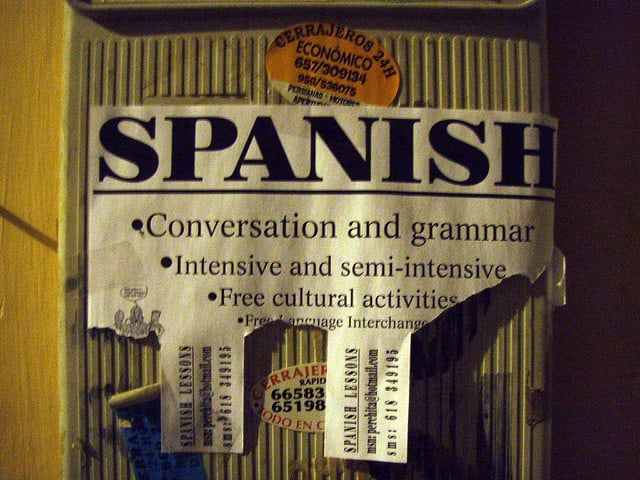Learning a language is hard. Just try to have a conversation with a three-year-old. Poor grammar, limited vocab, repeating familiar phrases…come on, kid! Is that the best you can do in three years?
For the first 30+ years of my life, I profited from English’s global popularity and never learned another language. But when I was sent to work in Central America, I suddenly confronted a future that wouldn’t allow me such comforts.
Now that I am several months into Spanish studies, I’d like to share five techniques that will help you on your way to learning a new language. Most of these suggestions fit with any language, but I am going to focus on Spanish.
Since Jesuit schools charge enough already, this “Jesuit Guide” offers five techniques that are free of charge. That’s right — FREE! Pretty exciting, right?
Without further ado…
* * *
1.) Read Spanish. Yes, Everything.
A library card gives you access to Spanish books of all levels. Choose something that works for where you are at. If you are a beginner, grab a children’s book and take it for a spin. Books with pictures can help you learn vocab more quickly. Here is a creative way to learn a new noun: go to “Google image search” instead of a translator. For example, type in “zanahoria” and search. When pictures of carrots pop up, you will be associating the Spanish word directly with the object it represents. Cut out the English word, and that is one less step in the process to fluency.
I also stumbled upon a great bilingual book with folk stories from Latin America. On one page, the story is in English, and on the facing page the story is in Spanish. This has been a great way to minimizing time spent flipping through a dictionary.
A Spanish newspaper or Spanish news articles on the internet can also be helpful. So far, I have found them to be most helpful at reminding me how poor my vocabulary is. It turns out that learning a language includes learning a ton of day-to-day words!
2.) Tune in to Spanish music, television, or movies.
Let’s thank the internet for making this easy and free. I am sure you have heard of Youtube, but have you heard of Crackle? Besides having all of Seinfeld on it, Crackle offers a bundle of free TV shows and movies in Spanish. Comprehension is generally harder when someone is speaking to you, compared with reading a text — in a conversation, you don’t have the luxury to choose the pace. Listening to Spanish in music or movies can really help.
Keep in mind: this is not exactly easy. How good are you at picking up lyrics in English? Did you think Elton John was bolting out, “Hold me closer, Tony Danza!” instead of “tiny dancer”? The struggle is real. I learned a helpful four-step process for using music to improve my oral comprehension skills:
Step one: Choose a song and give it a listen. Start by finding an artist whose music you can enjoy. For the first pass, just listen and see how well you can understand. Try to focus on some key words or phrases that you recognize. After the song, review what you think you heard.
Step two: Look up the lyrics. How did you do? Spend time with the lyrics and look up words you do not know until you understand the song.
Step three: Listen to the song while following along with the lyrics. This is when you will notice things like a singer slurring a few words together to stay with the rhythm. Welcome to the nuances of the vernacular.
Step four: Listen to the song again, but without the lyrics. Note your improvement. Congratulate yourself. Way to go!
3.) Use free apps.
Have you heard of Duolingo? The crowd-sourced website is using language learners (like you and me) to help translate actual websites on the Internet through their free exercises. Check out the story or TED talk if you want to learn more about how it is done. Or don’t. At the very least, enjoy a tool that can save you hundreds of dollars on programs like Rosetta Stone.
Duolingo is creatively animated, and feels like a game that makes the learning experience actually fun. The website tracks your progress as you move through levels. It’s like a game, but with learning.
Google also offers an app version of their translator. This has been improving dramatically from its once-robotic translations, since the website has started to incorporate user feedback. The app also markets a couple of technologies that sound exciting but need some work. For example, you can supposedly hold your camera over a page in one language and watch the words translate directly on your screen. It sounds better than it works, especially when words get hyphenated at the end of lines. But stay tuned! Improvements are on-going.
4.) Go to Mass — in Spanish.
This is a Jesuit Guide, remember? Well, Mass is free, and it is pretty easy to find a Mass in Spanish in the U.S. What better opportunity to practice your oral comprehension? If you are a regular Mass goer, you will be able to follow along with the Mass (spoiler alert: the rhythm of the responses are the same in every language).
Also, where else can you learn the Spanish for such important words as “all-powerful,” “everlasting,” and “omnipotent”? (That would be “todopoderoso,” “eterno,” and “omnipotente,” respectívamente) The Mass is also a great place to improve your familiarity with commands in Spanish (the dreaded subjunctive mood: gasp!).
- “Tomen y coman” = “Take and eat.”
- “Ten piedad” = “Have pity.”
- “Demos gracias a Dios” = “Let us give thanks to God.”
See how much you can learn just by going to Mass? As for the homily–you’re on your own. (I never said it would be easy.)
5.) Make Spanish-speaking friends.
At some point, you have to actually start using the language, right? And that means talking. So what could be better than making some friends who are Spanish speakers? It can be helpful to have a friend who is bilingual, who can prevent the conversation from grinding to a halt when a particular word or phrase is escaping you. The weak would resort to Spanglish. But you are not weak. The most helpful Spanish-speaking friends are those who will be patient, but persistent. No English allowed!
Trust me: speaking can be one of the hardest and most nerve-wracking parts of the language-learning process. The best approach to take is one of humility and good humor. You are not going to be great when you start. And everyone is okay with that! So be sure to take yourself lightly, and be ready to laugh at your own mistakes.
Note: I have heard rumors that dating a Spanish-speaker is even more helpful, but for obvious reasons, I cannot weigh in on the possible merits of such a technique. (Lo siento, pero soy celibato.)
BONUS: Nothing beats language Immersion.
So those are FIVE FREE techniques for improving your Spanish. Still craving more? Are you willing to pay to go the extra (thousand) mile(s)?
Nothing will improve your language abilities as much as an immersion experience. Latin American countries (and Spain) abound with language immersion schools. You will benefit from classes or (better still) one-on-one instruction. Many programs offer host families for lodging, which provide further opportunities to practice and keep you immersed.
One warning: keep your expectations reasonable! I just finished six weeks of a language program, and I am far from fluent. I met a handful of Americans who left the school disappointed that they did not progress as much as they expected in two short weeks…or a month…or…
Remember the three-year-old child? Poor grammar, limited vocab, repeating familiar phrases… it takes a long time to learn a language. If you really want to be proficient, it will probably take a commitment of six months to a year. But have reasonable expectations: you will feel much better about it if you do.
* * *
There you have it. You probably do a few of the things on this list already: read, listen to music, watch TV, go to Mass, hang out with friends. So why not try doing all of them, but in Spanish? Enjoy these free techniques to expand your language horizons. You will be pleased with the results!
¡Buena suerte! (“Good luck!” — but you probably already knew that.)
–//–
Title image by Daniel Lobo is available here on Flickr.


